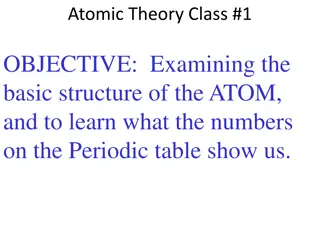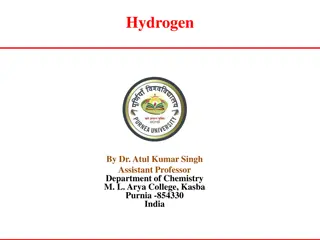Introduction to Atomic Masses and Mass Spectrometry
Understanding atomic masses, isotopes, and mass spectrometry in the context of chemistry, particularly the concept of standard atomic mass unit (amu) and its application in measuring the masses of atoms. The content delves into the composition of atoms, isotopes, and how to determine the mass of an
1 views • 20 slides
Understanding the Basic Structure of Atoms: Atomic Theory Class #1
Exploring the fundamental components of atoms, including protons, neutrons, and electrons, their charges, symbols, masses, and locations within the atom. We delve into the concept of atomic mass units (AMU) and the structure of the nucleus, as well as the behavior of electrons in relation to the nuc
0 views • 108 slides
Overview of Hydrogen: Properties, Isotopes, and Characteristics
Hydrogen, a colorless gas with atomic number 1 and mass 1.008 amu, exhibits electropositive and electronegative characteristics due to its electron configuration. It has three isotopes - protium, deuterium, and tritium - with varying reaction rates. Protium is the most abundant isotope. This element
0 views • 8 slides
Technical Tasks and Contributions in Plasma Physics Research
This collection of reports details the technical tasks undertaken in 2022 by AMU in managing interfaces with ACH for Eiron and IMAS, as well as contributions to EIRENE_unified. It also discusses the parallelization of rate coefficient calculations and the implementation of MPI parallelisation for ef
0 views • 10 slides
Insights into Healthcare-Associated Infections and Antimicrobial Use in Acute Care Settings
This report presents findings from a Point Prevalence Survey (PPS) on Healthcare-Associated Infections (HAI) and Antimicrobial Use (AMU) in acute care, highlighting the prevalence rates, distribution of infections, changes in infection rates, and patterns of antimicrobial consumption across European
0 views • 17 slides




